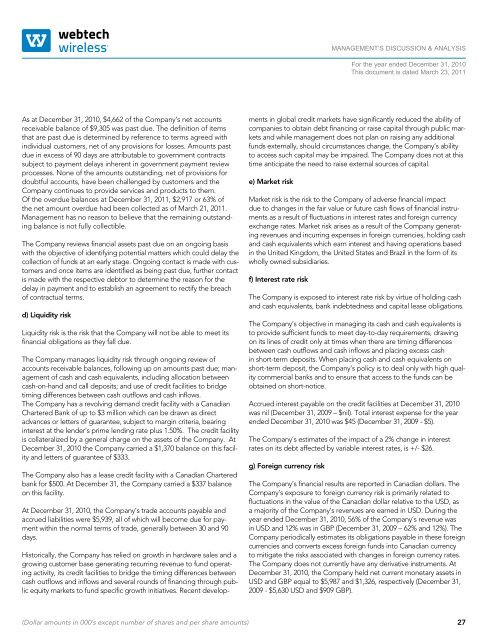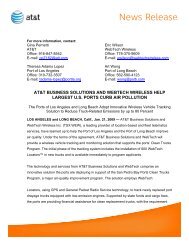2010 ANNUAL REPORT - Webtech Wireless
2010 ANNUAL REPORT - Webtech Wireless
2010 ANNUAL REPORT - Webtech Wireless
Create successful ePaper yourself
Turn your PDF publications into a flip-book with our unique Google optimized e-Paper software.
MANAGEMENT’S DISCUSSION & ANALYSISFor the year ended December 31, <strong>2010</strong>This document is dated March 23, 2011As at December 31, <strong>2010</strong>, $4,662 of the Company’s net accountsreceivable balance of $9,305 was past due. The definition of itemsthat are past due is determined by reference to terms agreed withindividual customers, net of any provisions for losses. Amounts pastdue in excess of 90 days are attributable to government contractssubject to payment delays inherent in government payment reviewprocesses. None of the amounts outstanding, net of provisions fordoubtful accounts, have been challenged by customers and theCompany continues to provide services and products to them.Of the overdue balances at December 31, 2011, $2,917 or 63% ofthe net amount overdue had been collected as of March 21, 2011.Management has no reason to believe that the remaining outstandingbalance is not fully collectible.The Company reviews financial assets past due on an ongoing basiswith the objective of identifying potential matters which could delay thecollection of funds at an early stage. Ongoing contact is made with customersand once items are identified as being past due, further contactis made with the respective debtor to determine the reason for thedelay in payment and to establish an agreement to rectify the breachof contractual terms.d) Liquidity riskLiquidity risk is the risk that the Company will not be able to meet itsfinancial obligations as they fall due.The Company manages liquidity risk through ongoing review ofaccounts receivable balances, following up on amounts past due; managementof cash and cash equivalents, including allocation betweencash-on-hand and call deposits; and use of credit facilities to bridgetiming differences between cash outflows and cash inflows.The Company has a revolving demand credit facility with a CanadianChartered Bank of up to $3 million which can be drawn as directadvances or letters of guarantee, subject to margin criteria, bearinginterest at the lender’s prime lending rate plus 1.50%. The credit facilityis collateralized by a general charge on the assets of the Company. AtDecember 31, <strong>2010</strong> the Company carried a $1,370 balance on this facilityand letters of guarantee of $333.The Company also has a lease credit facility with a Canadian Charteredbank for $500. At December 31, the Company carried a $337 balanceon this facility.At December 31, <strong>2010</strong>, the Company’s trade accounts payable andaccrued liabilities were $5,939, all of which will become due for paymentwithin the normal terms of trade, generally between 30 and 90days.Historically, the Company has relied on growth in hardware sales and agrowing customer base generating recurring revenue to fund operatingactivity, its credit facilities to bridge the timing differences betweencash outflows and inflows and several rounds of financing through publicequity markets to fund specific growth initiatives. Recent developmentsin global credit markets have significantly reduced the ability ofcompanies to obtain debt financing or raise capital through public marketsand while management does not plan on raising any additionalfunds externally, should circumstances change, the Company’s abilityto access such capital may be impaired. The Company does not at thistime anticipate the need to raise external sources of capital.e) Market riskMarket risk is the risk to the Company of adverse financial impactdue to changes in the fair value or future cash flows of financial instrumentsas a result of fluctuations in interest rates and foreign currencyexchange rates. Market risk arises as a result of the Company generatingrevenues and incurring expenses in foreign currencies, holding cashand cash equivalents which earn interest and having operations basedin the United Kingdom, the United States and Brazil in the form of itswholly owned subsidiaries.f) Interest rate riskThe Company is exposed to interest rate risk by virtue of holding cashand cash equivalents, bank indebtedness and capital lease obligations.The Company’s objective in managing its cash and cash equivalents isto provide sufficient funds to meet day-to-day requirements, drawingon its lines of credit only at times when there are timing differencesbetween cash outflows and cash inflows and placing excess cashin short-term deposits. When placing cash and cash equivalents onshort-term deposit, the Company’s policy is to deal only with high qualitycommercial banks and to ensure that access to the funds can beobtained on short-notice.Accrued interest payable on the credit facilities at December 31, <strong>2010</strong>was nil (December 31, 2009 – $nil). Total interest expense for the yearended December 31, <strong>2010</strong> was $45 (December 31, 2009 - $5).The Company’s estimates of the impact of a 2% change in interestrates on its debt affected by variable interest rates, is +/- $26.g) Foreign currency riskThe Company’s financial results are reported in Canadian dollars. TheCompany’s exposure to foreign currency risk is primarily related tofluctuations in the value of the Canadian dollar relative to the USD, asa majority of the Company’s revenues are earned in USD. During theyear ended December 31, <strong>2010</strong>, 56% of the Company’s revenue wasin USD and 12% was in GBP (December 31, 2009 – 62% and 12%). TheCompany periodically estimates its obligations payable in these foreigncurrencies and converts excess foreign funds into Canadian currencyto mitigate the risks associated with changes in foreign currency rates.The Company does not currently have any derivative instruments. AtDecember 31, <strong>2010</strong>, the Company held net current monetary assets inUSD and GBP equal to $5,987 and $1,326, respectively (December 31,2009 - $5,630 USD and $909 GBP).(Dollar amounts in 000’s except number of shares and per share amounts)27




